Fire!
This week: FIRE!; Aviation fire fighting; Rooftop shimmy; In flower this week; Some other work;
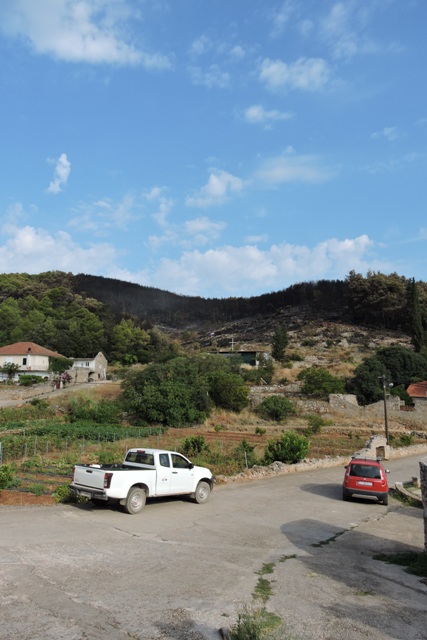
I have spent a lot of time this week making changes around home, as mitigation for any potential fires.
On Sunday we had a major fire on the hill called Hum, which separates the villages of Dol and Vrbanj.
What surprised me was when I went shopping on Thursday morning, that the actual (visible) burn area is relatively small.
The Vatrogasci were still damping down at the scene and there were wisps of smoke visible over the blackened hillside.
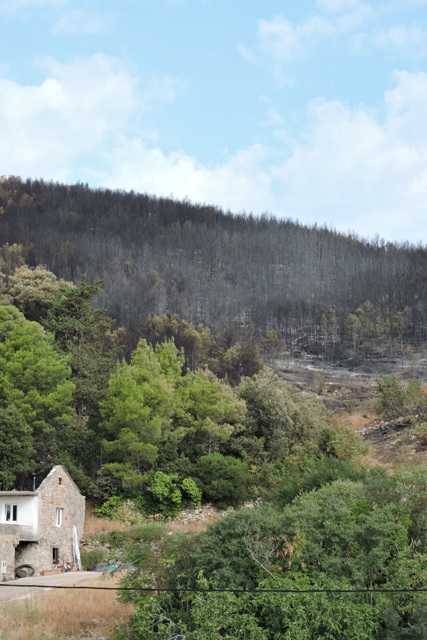
Using Google Earth I assess the actual area to be between 1.5 and 2 square kilometers.
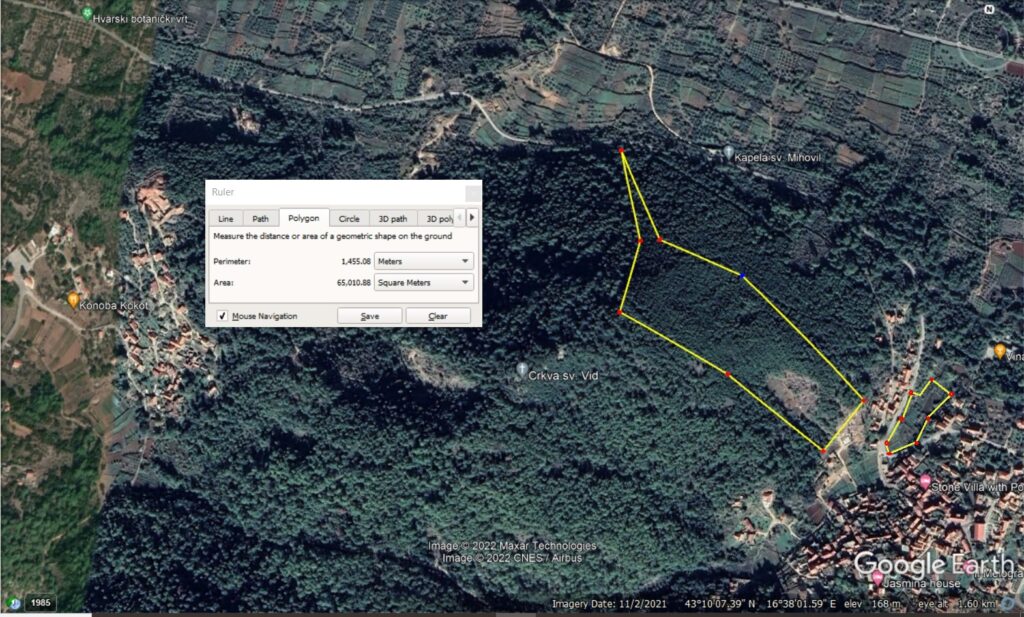
On going fires at this moment, in other countries, for example the McKinney fire in northern California covers 248 square kilometres and in France the Gironde fire has scorched 68 square kilometres.
More than 1,000 firefighters from across Europe are fighting the Gironde fire.
Despite that in the scale of things our fire is a very small fire, my village was saved by the wind, which was blowing strongly in the opposite direction.
The local Vatrogasci (FRS) responded with every resource they had and five water bombing aircraft were deployed. It is because of the work of the combined air and ground forces that the fire didn’t claim any buildings.
I worry because I am 25 or 30 meters from the actual forest. However when I look at the houses on the other side of the valley, where they are built into the forest, it is a disaster waiting to happen.
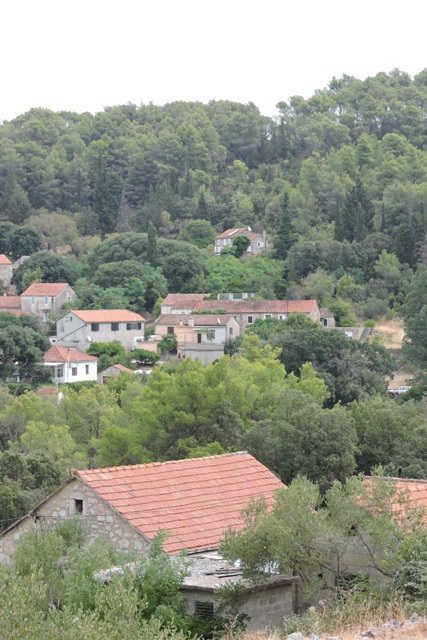
Sadly one man died trying to move his large tracked JCB excavator, when the flames overtook him.
With a value of €100,000 for these large machines, I can understand why he wanted to save it. However forest fires move faster than a man can run, which is a lot faster than a crawler JCB.
A major cause of the fire spreading is wind borne burning embers, blowing ahead of the fire.
I was also surprised to see the the fire had indeed jumped the main road in Vrbanj and had burnt through a couple of small olive groves, and orchard and allotment.
The orange line (below) shows where the advancing fire was stopped and the arrow shows where wind borne embers ignited dry orchard grass.

When I look at my immediate absent neighbours derelict land, I worry even more….
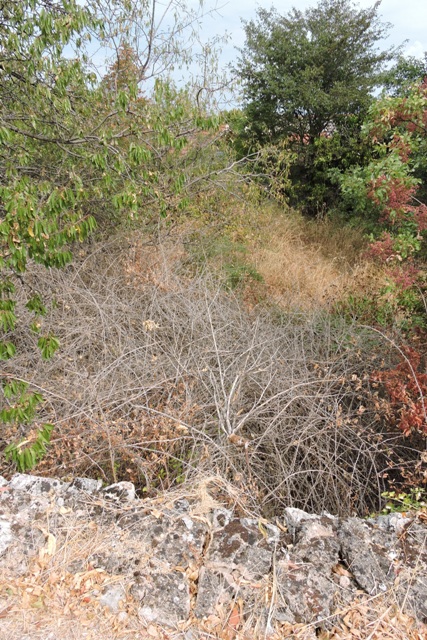
FIRE!
It was going to happen, not an if but a when. I said this specifically in last week’s blog.
Most of the rural fire and rescue services (FRS) in Croatia are volunteer departments.
They are professional, well trained and drilled, and have generally new appliances, with some older machines as backups. Only in the large cities and towns are there full time brigades.
My local FRS has a local chief and deputy whom I know well and who are full time, everyone else is a volunteer, me included.
My job is to service and maintain a large drone, which is almost never needed, because drones and water bombers don’t mix.
The major risk is wildland fires, with road crashes a second regular call. House / structure fires are mercifully few.
As the world gets warmer and dryer, so the risk of fire increases and firefighters talk about the Wildland-urban interface (WUI) .
This is where land and property, maintained land and the built environment meets and intermingles with uncultivated land, forest and in the case of Dol the Maquis.
My WUI is less than 25 metres, which is a long way from the recommended 200 meters of clear area around buildings.
Because of this I am as prepared as I can be. I have hose pipes attached to the rising main, and kept fully charged ready. I have NOMEX fire protection, because we used to fly in Nomex all the time, but it isn’t “Fire Proof”.
Nothing really is, NOMEX is fire retardant and over time and washing loses its protective qualities..
I was in my study just after lunch when I heard the siren of an emergency vehicle, fairly close, on the road between Stari Grad and Vrbanj.
Sirens are not a regular part of the soundscape here and usually mean a vehicle crash. Then there was a second, then a third.
I went out to investigate and could see smoke just beginning to rise above the hill called Hum 800 meters to the East.
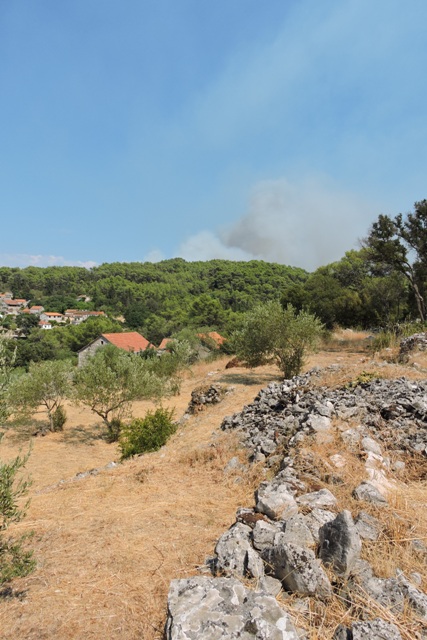
This is the hill that the run rises above in summer.
The smoke wasn’t too thick, however I know the danger because everything is so dry.
I checked my weather station, temperature over 37ºC, Wind 20 kph gusting to 25 kph from the north west, so taking the smoke away.
I walked round to my immediate next door neighbour to warn them. However it’s siesta time so there was no answer.
I went round to other neighbours, but the “Jungle Telegraph” was working well and a couple already knew. Other nearby houses were empty.
So I walked back towards home. I wasn’t prepared for how the fire had grown in less than 10 minutes.
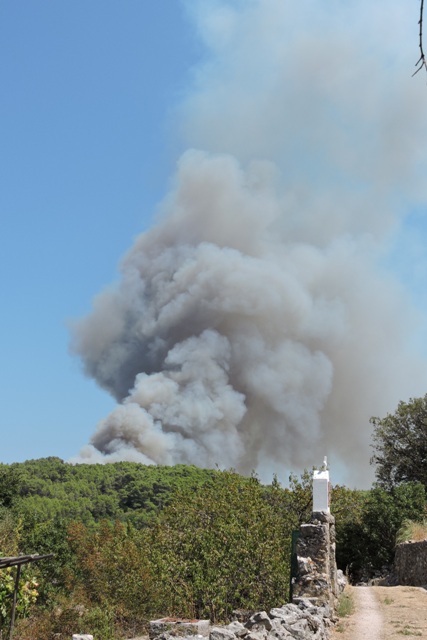
This was now a major forest fire, so I started to warn people on the English language social media.
The two immediate local FRS were already booked out according to Facebook, and the Grad Hvar FRS were on their way, but from 26 km away.
I couldn’t see any waterbombers in the air on FlightRadar24, but that didn’t mean they hadn’t been called, so I got my camera and started to go to a vantage point.
However I turned back after a few yards because I realised I had metallic objects in my pockets. No matches or lighters, but it only needs a spark, so I emptied my pockets.
As I watched the massive and growing cloud of smoke I could also see and hear a procession of FRS vehicles.
The wind was gusting, but was still taking smoke well away and because of the hill, I could see little more than the smoke.
Then I heard the arrival of the Cavalry, the Air Force CL-415 water bombers.
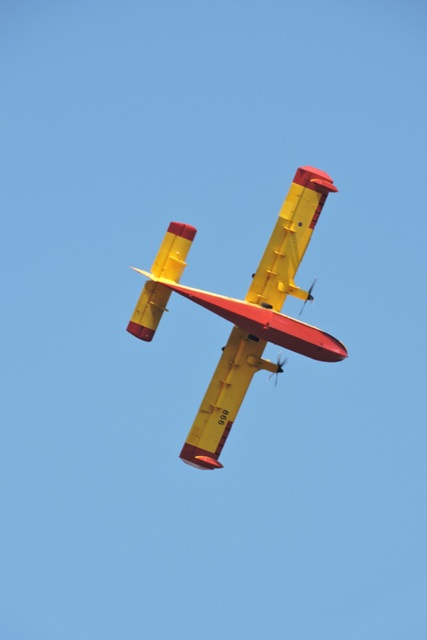
Flying low, slow and fully loaded, they immediately began attacking the fire.
Aviation fire fighting
In Croatia, airborne fire fighting is the responsibility of the Air Force. The Protupožarna eskadrila squadron are based at the Zadar Zemunik airport which is in the centre of the long Adriatic coastline.
They have four Canadairs and three Air Tractors with air force crews, but are deployed from a joint MOD, MUP and FRS coordination centre in Split.
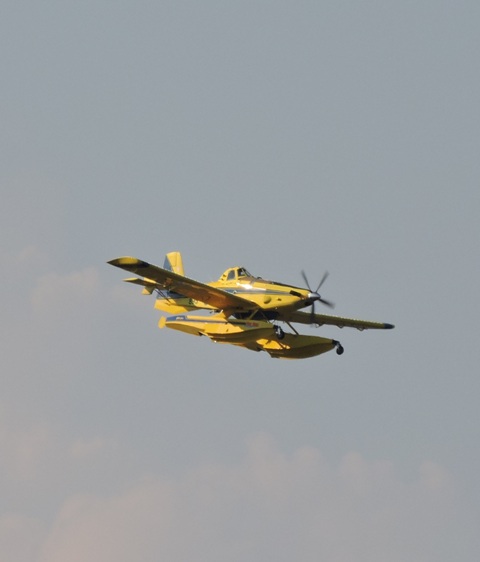
There are also some of the old Mi-8 helicopters with Bambi buckets and a PC-9 for the Fire Controller, at very large fires.
After dropping water, he aircraft immediately return to the sea, fill up while skimming the water and return. Each circuit takes only five minutes.
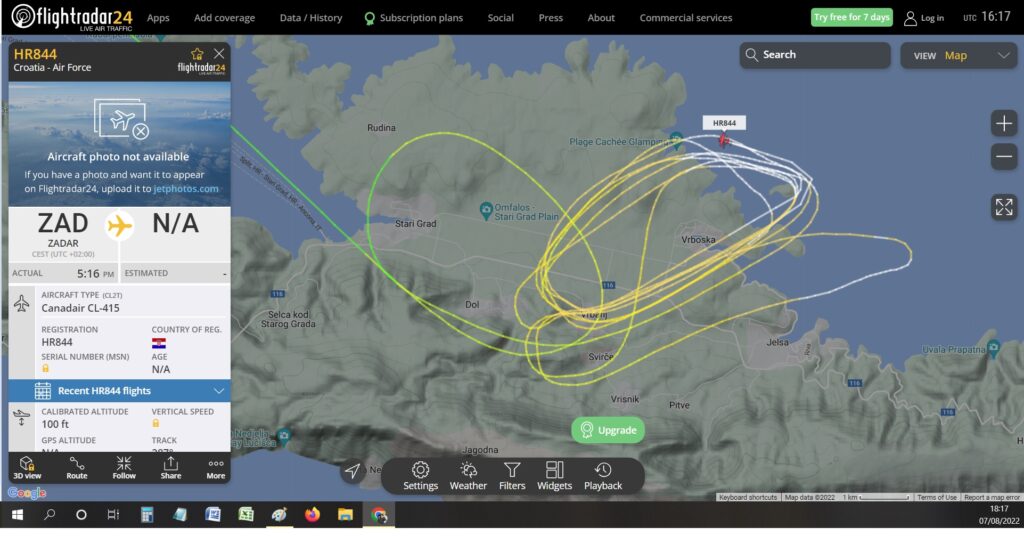
The problem is that the hillsides are steep and have no fire roads. This is the hill behind my home with contour intervals of 10 meters.
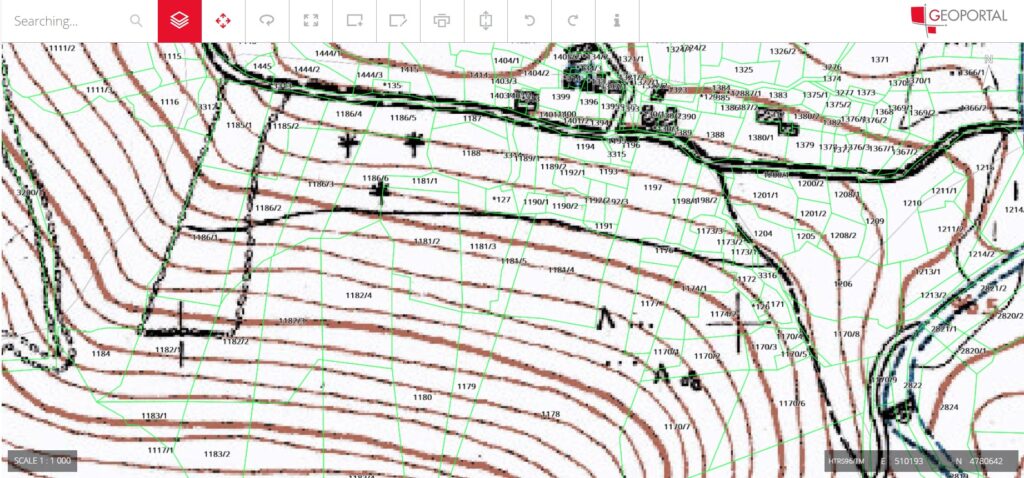
The green lines are the individual plots, with the reference number, all owned by different people. Less than half a dozen plots on this hillside are maintained to any degree.
There is no vehicle access, even for a 4 x 4, so the options are water bombers or firefighters on foot. There is nothing in between.
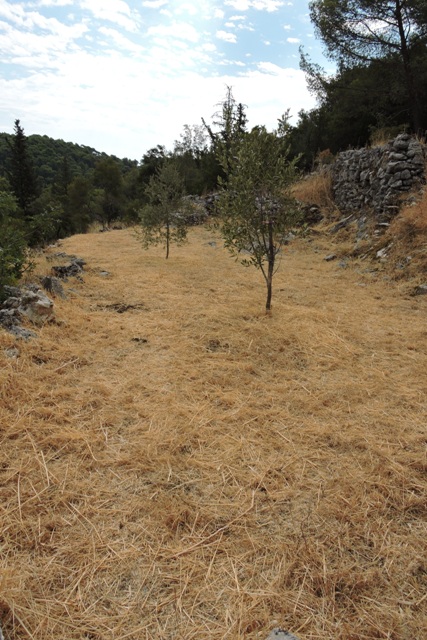
The few maintained terraces are centimetres deep in cut grass mulch. This was why I made sure I was carrying nothing metallic.
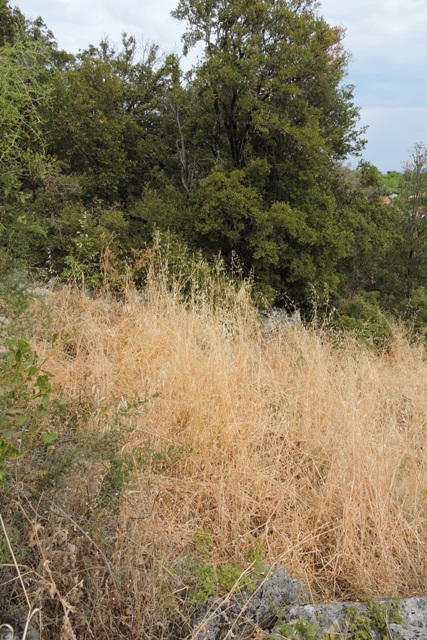
The Maquis has claimed the unmaintained plots. They are just as dry, but untouched, and the evergreen trees are full of flammable oils.
I have searched for WWII archive photographs of Hvar. This was an active theatre in the fight against the Axis powers, so they were taken, but so far are not available on-line.
I found a 1968 aerial photograph, of the same area as the contour map above.
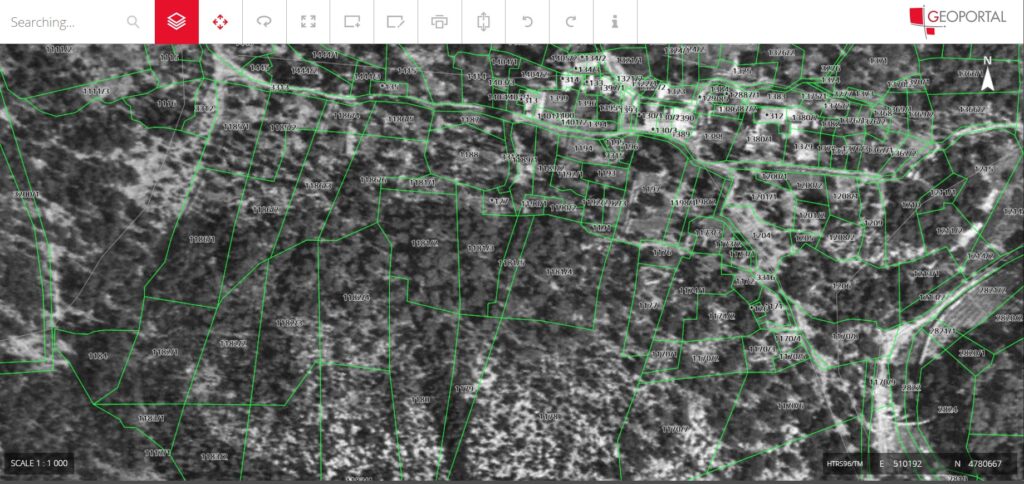
Contrast that with an aerial photograph from 2021.
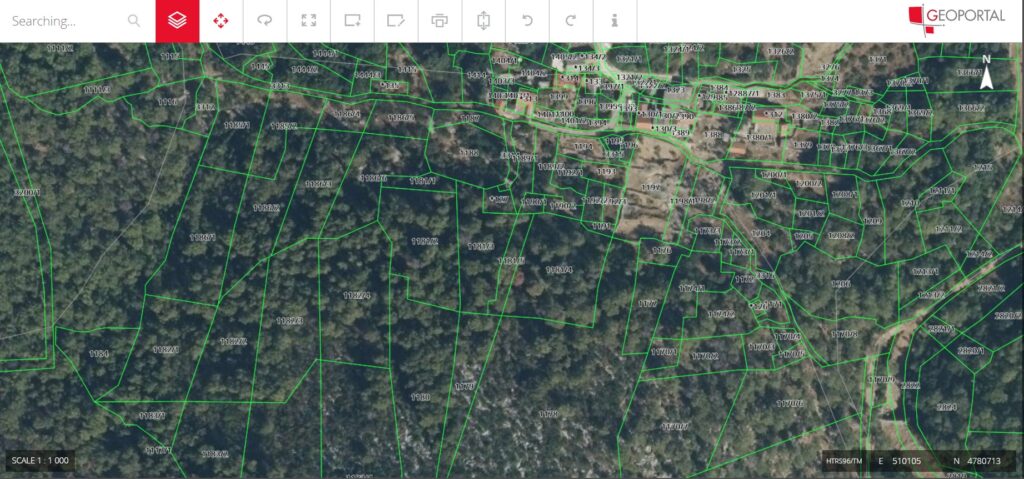
Even without colour, it is easy to see how the hillsides all around the village have been allowed to become overgrown. Just one area, in the right centre, has been brought back into cultivation.
Under the trees there is a dense understory of dead branches, fallen trees and oil rich shrubs, just waiting for a spark.
With abundant, dry fuel, few paths, and those which exists being narrow, the only way to effectively fight a fire in this terrain is from the air.
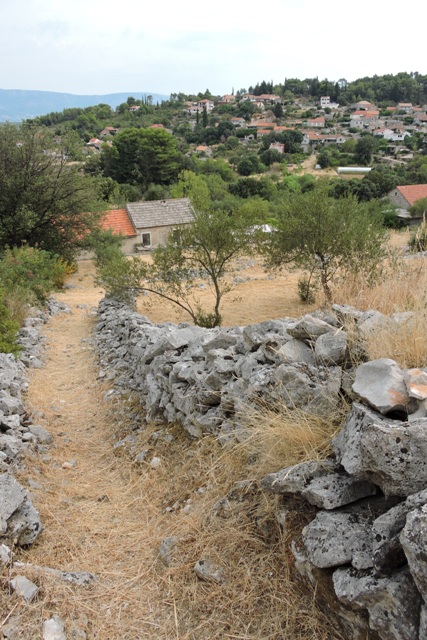
Rooftop shimmy
There are always so many jobs which need doing, some are weather dependant, some non urgent, with one or two waiting for parts to come in the post.
Sometimes I think I’ll do the job when I get around to it. Then something happens, like the fire, and I think I had better get my round tuit out of the cupboard!
After a very hot and sticky night on Sunday, when the temperature at 02:30 was still 28ºC, there was a little cloud on Monday morning.
Although the air temperature was over 30ºC, without sunshine, it made working on the roofs a possibility.
I’ve known a for a while that I need to clear leaf litter and other detritus from the gutters, so I was out early to remove everything.
What did surprise me was how many overhanging branches there were, especially over the cottage.
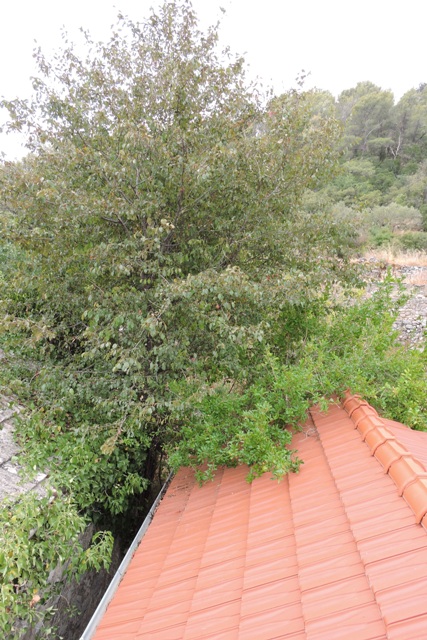
It wasn’t a long job with a pair of parrot bill cutters, to slice through and remove the branches, because they were only the thickness of your thumb.
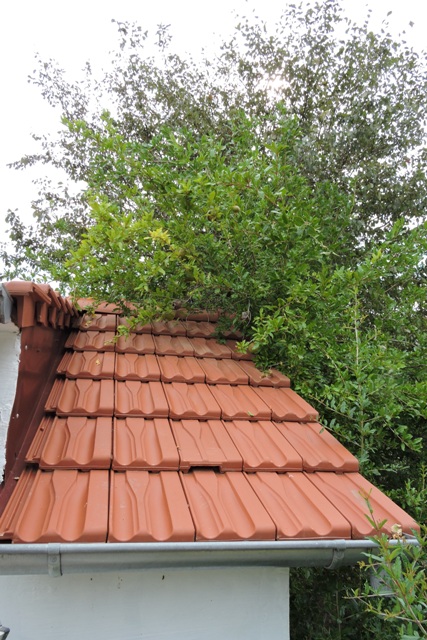
Next I cleared the gutters of leaves and twigs.
Close to the kitchen I have allowed a Goji Berry and Šipac to take over.
I cut through everything to make a path to the wall and then cut down the orange tree with the chain saw.
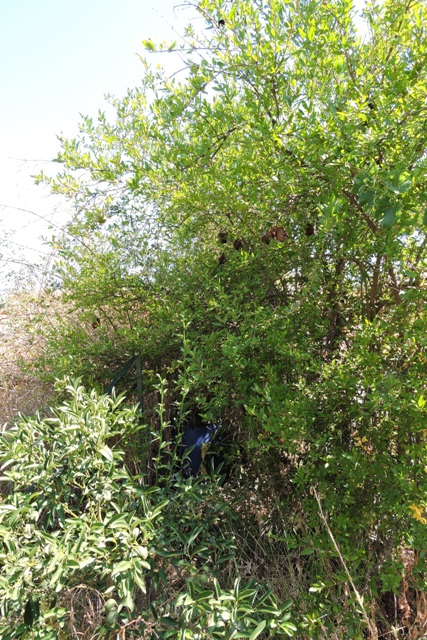
This is an old tree which was killed in the heavy winter freeze we had in 2017, when I lost all my Citrus.
However it sprouted again from the base of the trunk, and I have been waiting to see if it produced any fruit.
It hasn’t done so and because it is clearly under stress, by the curled leaves and it is too close to the house anyway, I decided to take it down.
There is a reason here why trees are planted so close to houses, and that is that they provide shade in summer reducing the heat gain on the walls.
Walls are solid and thick, but even a 1 metre thick wall feels warm on the inside in summer.
Having removed the orange, I realised the it had been hiding another problem.
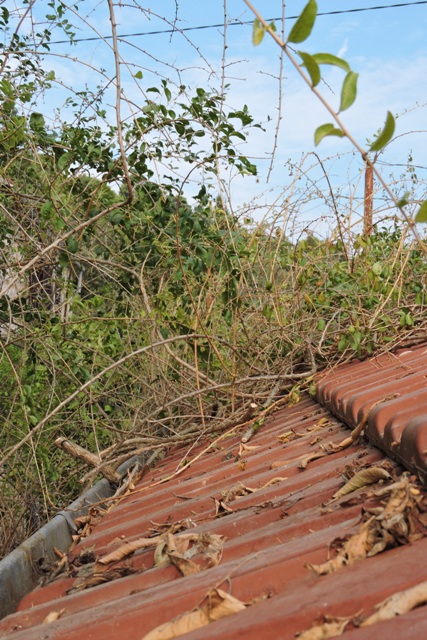
I have several Goji Berry shrubs. These grow long tentacles, very long tentacles in some cases and they had covered probably half of the kitchen roof.
Everything has now been removed, I then swept the roof and cleaned out the gutter.
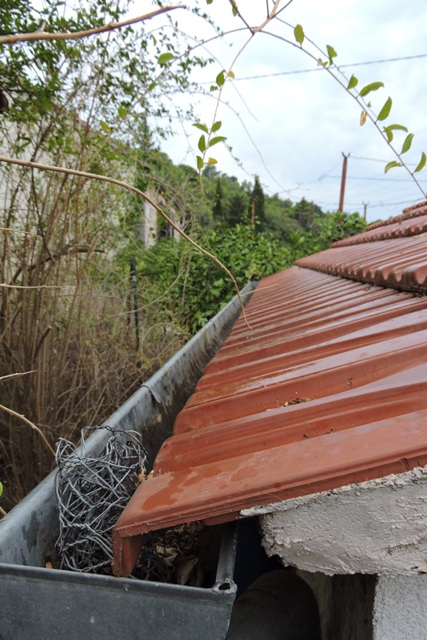
This would have been an absolute fire trap in a forest fire. Burning embers which can travel up to a kilometre ahead of the fire on a strong wind, would have set fire to the debris with ease.
So with all the gutters cleaned, I am happy about my defensive plans. This is now going to be an annual spring-time task because of the ongoing threat for fire from climate breakdown.
It will take some serious work to create a completely clear two meter area around all my buildings, so I’m going to think about that job!
In flower this week
Not everything is doom and gloom.
This week my first Spider Lily flowers have opened. Here a Carpenter Bee, Xylocopa violacea is feeding on the nectar rich flower.
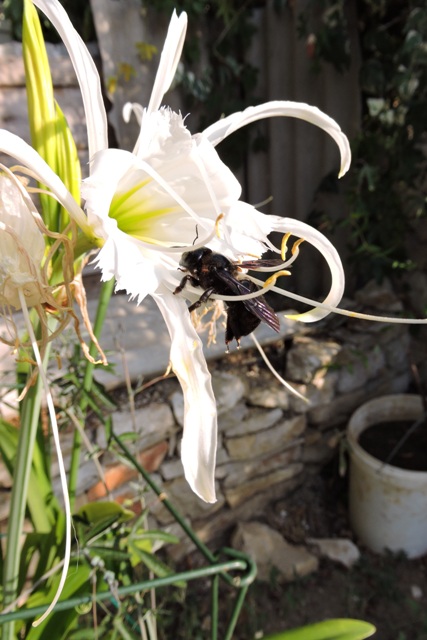
This is the Hymenocallis, a native of Mexico and central America, so it enjoys the summer heat, although would probably like more water!
In the orchard flower bed, the Buddleja madagascariensis continues to attract butterflies.
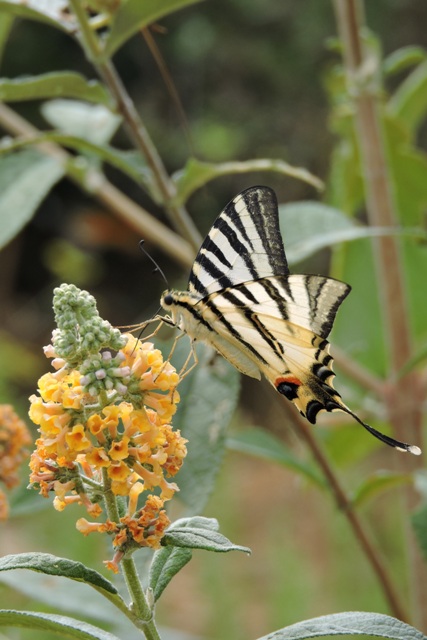
These are the Scarce Swallowtail, Iphiclides podalirius, a regular summer visitor.
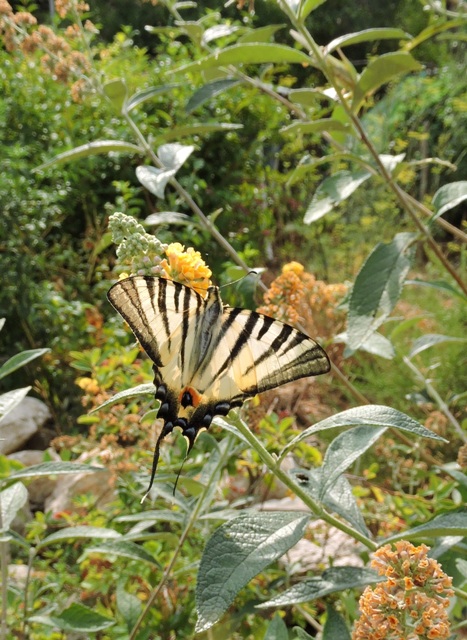
There was a commotion outside the door on Saturday afternoon. I thought one of the felines had brought me a present, but what I found was a Paper Wasp’s nest was being attacked by a hornet.
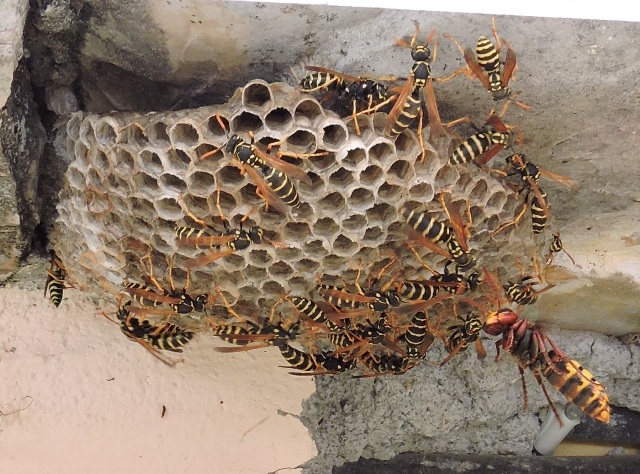
Both of these insects do a lot of good work for the Gardner and grower.
They are constantly bringing insect larvae and small caterpillars to feed their young. The Paper Wasps, Polistes gallicus, create small mushroom shaped nests, under the eaves of buildings, where their larvae grow. They don’t bother me, so I don’t bother them.
Like wise the European Hornet, Vespa crobro, also don’t seem to be bothered by humans and generally keep out of the way, even though they are 4 cm in length.
This is the first time I have ever seen a hornet attacking a Paper Wasp nest though.
The wasps were having none of it and kept knocking the hornet to the ground, which is what had excited the felines.
Eventually the hornet got the message and flew off.
Some other work
At first glance, you could be forgiven for thinking that I have done nothing this week except worry about the threat of fire.
In practice, I have been doing all the usual jobs and chores.
I have planted a series of bulbs for next spring and summer down in the Top Orchard side bed.
Rain was forecast for Saturday lunchtime and I was delighted to watch a thunderstorm approach from the west.
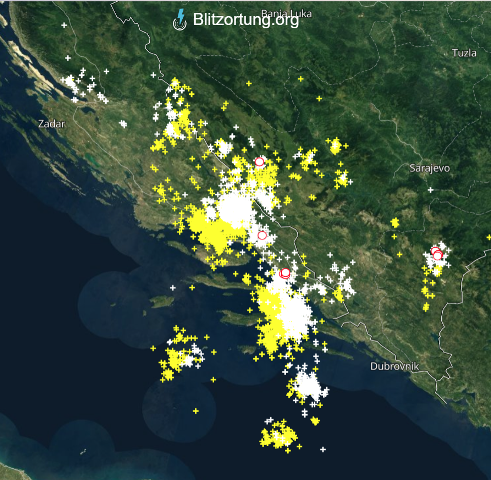
Sadly it was an almost dry storm. My rain gauge registered 0.75 mm, in Stari Grad they fared better receiving 2.1 mm and in Vrboska there was 1.4 mm, so when I finish this, I will be off out to irrigate again.
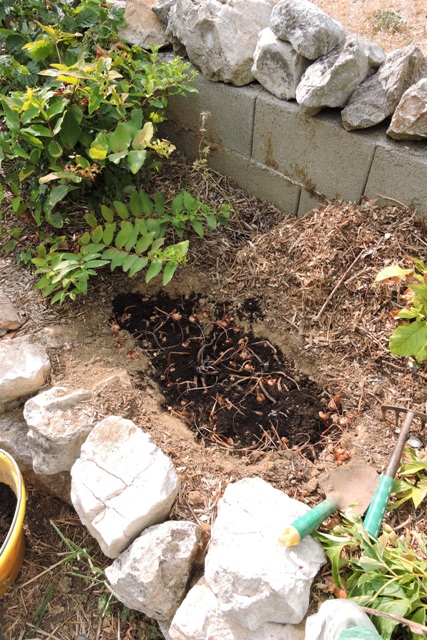
The soil was dry and baked hard because it is a clay loam, so I bedded all the bulbs in with a peat substitute. This I watered, making sure it was well soaked.
I replaced the soil and then covered everything with mulch to keep the moisture in.
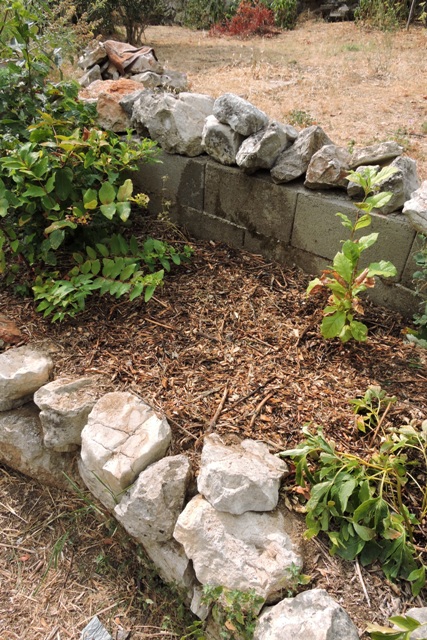
Next spring, I’ll show you the before and after photographs!
On hot afternoons I have been getting ready to scan some prints, negatives and slides.
There are several very full boxes of analogue material which I need to scan, so I have been trying to commission a dedicated computer for the task.
The problem is the Windows password has been lost and so I am having to “break” in.
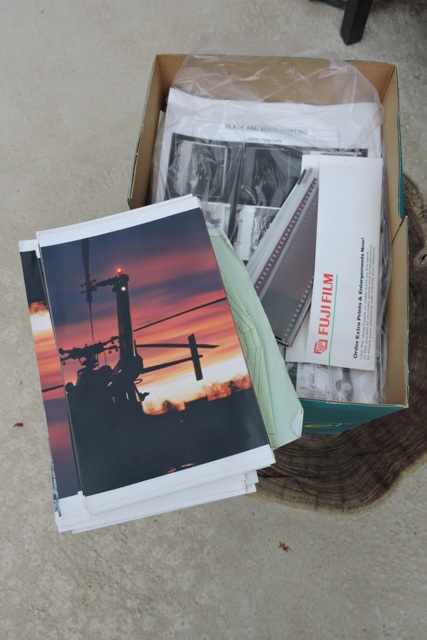
After several tests I have been able to break into the computer but haven’t been able to reset the password.
So as usual, it is a work in progress to be continued next week. NCG
One Response
Marcy
Norman, thank you for the update. As you pointed out, better to get the house ready than to wait until it’s too late. I hope people get the message that climate disruption is a real and present danger.
Your spider lily is stunning as are the butterflies. Hoping you have a cooler and more pleasant week.